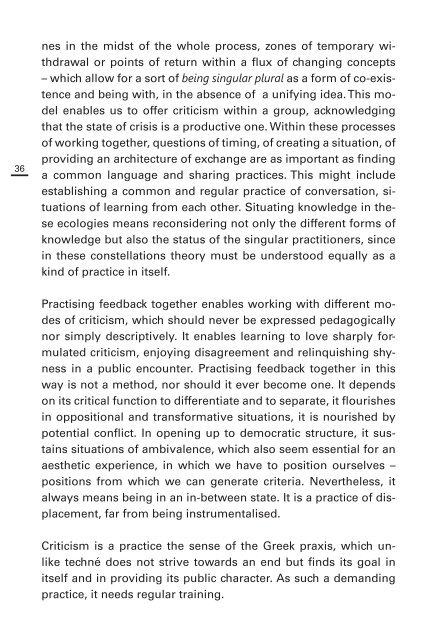Laboratory on Feedback in Artistic Processes 3
In its third edition the "Laboratory on Feedback in Artistic Processes" reflects on "Responses" within performing arts. The results of the previous Labs highlighted the need to take a closer look at the complexity and often subtle implications of feedback within the the artistic process itself. How do artist organise feedback and how do they process it? Who they want feedback from and what are its different roles? How can describe these relationships, and how does it shpae the artistic work? This booklet presents the different views on and experiences of feedback practices that were elaborated during the lab along the beforementioned questions and the insightfull contributions of its participants. Underpinning the following pages, three thematic fields have emerged: the impacts of feedback, feedback as a tool, and practicalities and contexts of feedback.
In its third edition the "Laboratory on Feedback in Artistic Processes" reflects on "Responses" within performing arts. The results of the previous Labs highlighted the need to take a closer look at the complexity and often subtle implications of feedback within the the artistic process itself. How do artist organise feedback and how do they process it? Who they want feedback from and what are its different roles? How can describe these relationships, and how does it shpae the artistic work?
This booklet presents the different views on and experiences of feedback practices that were elaborated during the lab along the beforementioned questions and the insightfull contributions of its participants. Underpinning the following pages, three thematic fields have emerged: the impacts of feedback, feedback as a tool, and practicalities and contexts of feedback.
Create successful ePaper yourself
Turn your PDF publications into a flip-book with our unique Google optimized e-Paper software.
36<br />
nes <strong>in</strong> the midst of the whole process, z<strong>on</strong>es of temporary withdrawal<br />
or po<strong>in</strong>ts of return with<strong>in</strong> a flux of chang<strong>in</strong>g c<strong>on</strong>cepts<br />
– which allow for a sort of be<strong>in</strong>g s<strong>in</strong>gular plural as a form of co-existence<br />
and be<strong>in</strong>g with, <strong>in</strong> the absence of a unify<strong>in</strong>g idea. This model<br />
enables us to offer criticism with<strong>in</strong> a group, acknowledg<strong>in</strong>g<br />
that the state of crisis is a productive <strong>on</strong>e. With<strong>in</strong> these processes<br />
of work<strong>in</strong>g together, questi<strong>on</strong>s of tim<strong>in</strong>g, of creat<strong>in</strong>g a situati<strong>on</strong>, of<br />
provid<strong>in</strong>g an architecture of exchange are as important as f<strong>in</strong>d<strong>in</strong>g<br />
a comm<strong>on</strong> language and shar<strong>in</strong>g practices. This might <strong>in</strong>clude<br />
establish<strong>in</strong>g a comm<strong>on</strong> and regular practice of c<strong>on</strong>versati<strong>on</strong>, situati<strong>on</strong>s<br />
of learn<strong>in</strong>g from each other. Situat<strong>in</strong>g knowledge <strong>in</strong> these<br />
ecologies means rec<strong>on</strong>sider<strong>in</strong>g not <strong>on</strong>ly the different forms of<br />
knowledge but also the status of the s<strong>in</strong>gular practiti<strong>on</strong>ers, s<strong>in</strong>ce<br />
<strong>in</strong> these c<strong>on</strong>stellati<strong>on</strong>s theory must be understood equally as a<br />
k<strong>in</strong>d of practice <strong>in</strong> itself.<br />
Practis<strong>in</strong>g feedback together enables work<strong>in</strong>g with different modes<br />
of criticism, which should never be expressed pedagogically<br />
nor simply descriptively. It enables learn<strong>in</strong>g to love sharply formulated<br />
criticism, enjoy<strong>in</strong>g disagreement and rel<strong>in</strong>quish<strong>in</strong>g shyness<br />
<strong>in</strong> a public encounter. Practis<strong>in</strong>g feedback together <strong>in</strong> this<br />
way is not a method, nor should it ever become <strong>on</strong>e. It depends<br />
<strong>on</strong> its critical functi<strong>on</strong> to differentiate and to separate, it flourishes<br />
<strong>in</strong> oppositi<strong>on</strong>al and transformative situati<strong>on</strong>s, it is nourished by<br />
potential c<strong>on</strong>flict. In open<strong>in</strong>g up to democratic structure, it susta<strong>in</strong>s<br />
situati<strong>on</strong>s of ambivalence, which also seem essential for an<br />
aesthetic experience, <strong>in</strong> which we have to positi<strong>on</strong> ourselves –<br />
positi<strong>on</strong>s from which we can generate criteria. Nevertheless, it<br />
always means be<strong>in</strong>g <strong>in</strong> an <strong>in</strong>-between state. It is a practice of displacement,<br />
far from be<strong>in</strong>g <strong>in</strong>strumentalised.<br />
Criticism is a practice the sense of the Greek praxis, which unlike<br />
techné does not strive towards an end but f<strong>in</strong>ds its goal <strong>in</strong><br />
itself and <strong>in</strong> provid<strong>in</strong>g its public character. As such a demand<strong>in</strong>g<br />
practice, it needs regular tra<strong>in</strong><strong>in</strong>g.


















